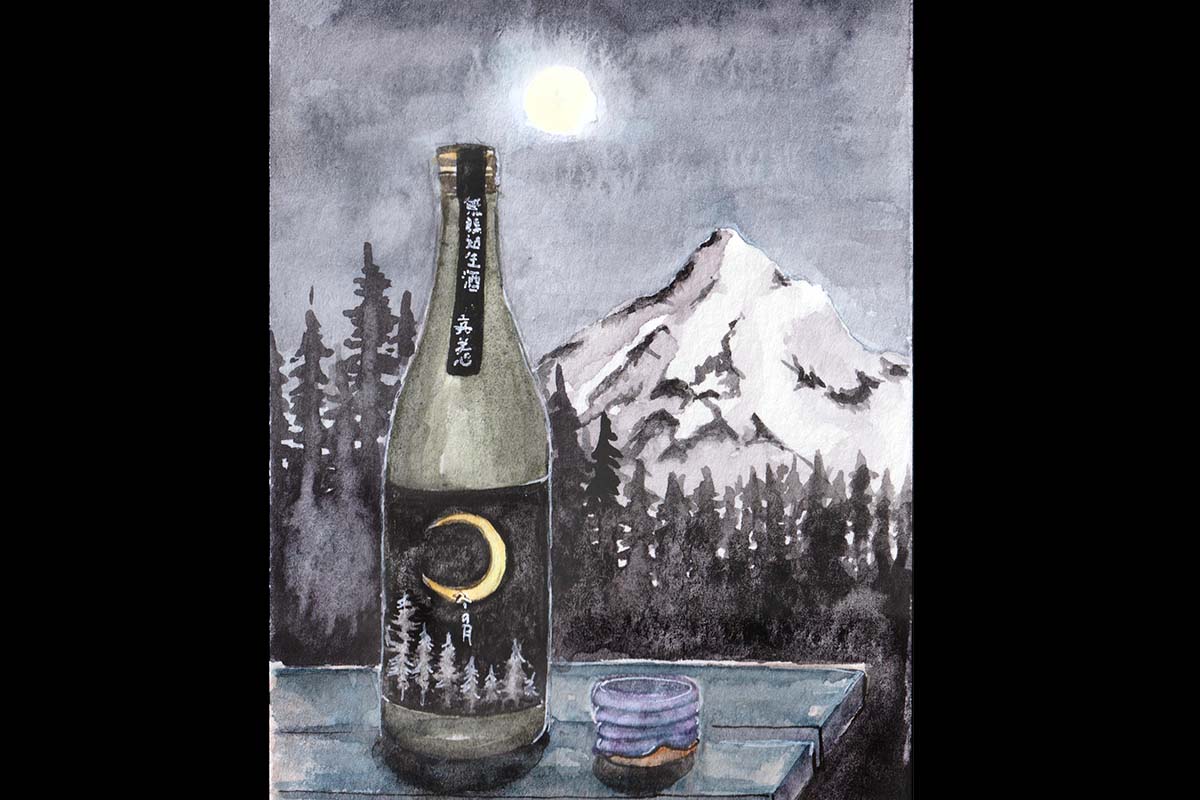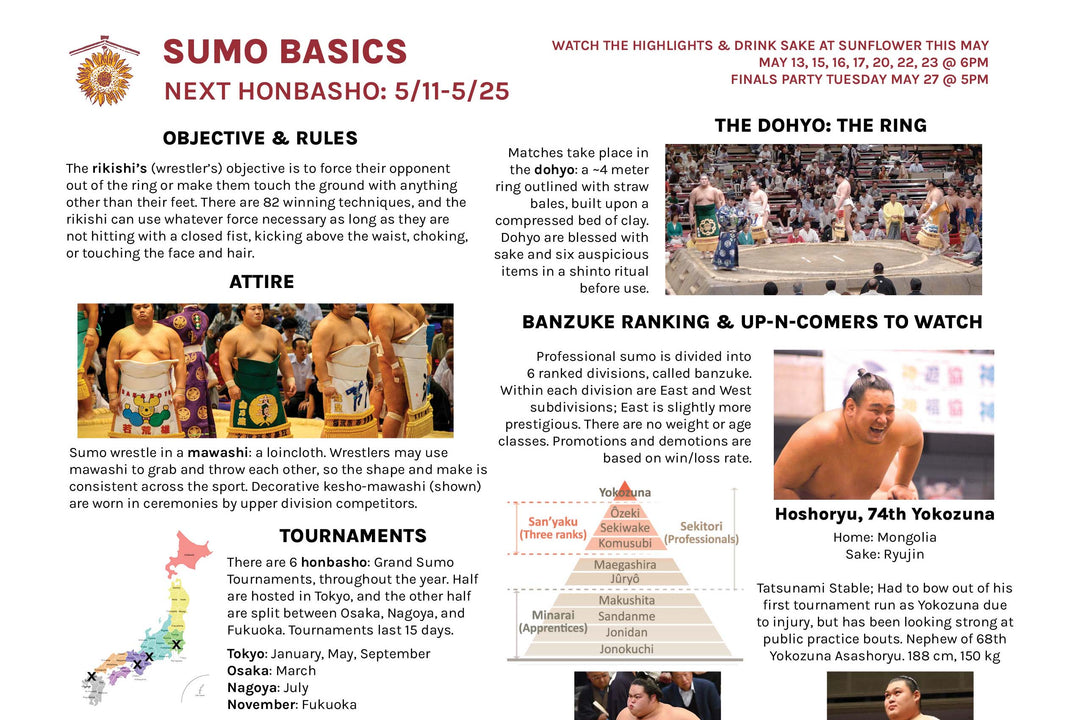APR 25: Spring Namas! Kamikokoro 'Fuyu no Tsuki' and Kisoji Junmai Ginjo Shiboritate


Kamikokoro Junmai Ginjo Muroka Nama Genshu
As chance would have it, Kamikokoro is celebrating 25 years of Fuyu no Tsuki (Winter Moon) in 2025!
When Fuyu no Tsuki was first introduced in Y2K, Kamikokoro produced only 726 bottles. Utilizing Nihonbare table rice grown in Okayama, Shizuku filtration (gravity-drop, bag filtration typically reserved for premium daiginjo) and Okayama white peach yeast (they are famous for their white peaches) Fuyu no Tsuki bucked trends with its high-low philosophy. The resulting rich and umami-dense Muroka Nama Genshu (unfined, unpasteurized, undiluted) sake was nothing like the light and dry Tanrei Karakuchi-style sake drinkers were chasing at the time.
Since 2000, batch sizes have grown dramatically and refrigerated distribution has advanced, and in 2019 Fuyu no Tsuki landed for the first time in the USA. I remember ordering it for the first time in 2022, the most expensive nama I’d ever bought for the shop (!!)-- but I was smitten. 6 whole bottles! Back then, that was a huge commitment.
As of 2025, the heart of this sake remains unchanged but recently Kamikokoro has switched from Nihonbare to Akihikari (also a table rice) for the kakemai (primary fermentation rice). The reasoning is difficult to unravel, but resources refer to a local SDG (Sustainable Development Goal) program in Satoumi, Okayama that uses oyster shells as soil conditioner for Akihikari, and Kamikokoro has been a staunch advocate of this method. Given its warm, sunny southern climate Okayama is famous for its agriculture, rice in particular, and this has given rise to an uncanny number of breweries focused on non-interventionist rice for sake.
We love sharing the love, and thankfully Kamikokoro is not only open to feedback but with Fuyu no Tsuki they invite it: for 20 years they’ve attached survey cards to the neck of every (Japanese) bottle of sake sent into the market Because the exports don’t have these neck tags, we made our own postcards instead, with a little painting I (Nina) put together of our own Portland Fuyu no Tsuki ;) During the busy season Kamikokoro receives 8-11 completed surveys per day, and the owner often writes a handwritten response. From an interview he says, “I guess it's because my grandmother told me to learn calligraphy and hard-pen writing, and I won many competitions. I don't have any trace of that now, but... I often reply to customer surveys by hand, so it's useful.”
Initiatives like survey cards attached to bottles, hosting community events, and Kamikokoro’s involvement in the Satoumi oyster shell farming method demonstrate their commitment to their community. This commitment runs so deep that the brewery saw sales increase during the COVID-19 pandemic (compared to a 30-50% drop on average) thanks to 5th generation president Fujii Nobuhiko penning ~2,000 handwritten letters to liquor stores and restaurants, thanking them for their patronage. Kamikokoro has shared their mailing address with us graciously, and awaits our notes, too :)
Stats
-
Brewery: Kamikokoro Shuzo, 嘉美心酒造
-
Brand: Kamikokoro, loosely meaning, "the joy of a pure heart and spirit"
-
Grade: Junmai (pure rice) Ginjo (<60% polish) Muroka (unfined) Nama (unpasteurized) Genshu (undiluted)
-
Location: Asakuchi, Okayama prefecture
-
Rice: Satoumi Akihikari
-
Polishing: 58% (42% removed)
-
Yeast: Okayama white peach yeast (isolated from the skins of Okayama’s famous white peaches)
-
ABV: 16.5%
-
Acidity: 1.7 (a touch high)
-
SMV: -3 (slightly sweet)
The Asakuchi city based brewery close to the Seto Inland Sea owes their style to Okayama’s Bicchu Toji guild: a historic organization of sake brewers located in the inland Okayama region named Bicchu. Their signature is gentle sweetness balanced with a rich umami backbone, and utilization of Okayama’s local rice varieties. Okayama rice: heirloom, table, and sake rice alike, enjoy cult status among brewers, eaters and drinkers for its dynamic expressiveness, and Bicchu Toji have coaxed out its best qualities for generations.
L: Isn’t this so cute? The Brewers wear aloha shirts when they make their Summer sake!
Top R: The brewery hosts lots of events and parties, and one of them is mochi (and sweets) throwing for kids and adults, and providing shuttles so that adults can drink sake.
Bottom R: The owner (bottom left) celebrating (a little too much) the 25th anniversary of Fuyu no Tsuki with friends in Kurashiki, Okayama!
Kisoji Junmai Ginjo Nama Genshu Shiboritate
Led by Yugawa Naoko (company president and brewer) and her husband Yugawa Shinichi (toji), Yukawa Shuzoten is tucked away in Nagano prefecture’s Kiso Valley, a less-traveled village along the historic Nakasendo trail. The brewery sits at an elevation of 936m (3000 ft), either the highest or second highest elevation brewery in Japan depending on how you measure it.
For the Oregonians, Kiso Village is a bit like Welches: it's far enough up the local mountain (Mt. Hachimori, 8k ft) that you are immediately aware of your alpine surroundings but not so far that it's under deep snow all Winter. It’s a historic stop along the Nakasendo trail, the ancient footpath from Edo to Kyoto which was used by merchants and travelers for over 1000 years, and many of the buildings (including Yukawa Shuzo!) are equally historic. The village is too high for rice cultivation– frost comes too early– so the Yukawas have taken the initiative to develop deep relationships with the farmers downslope. In addition, they are located at the headwaters of the Kiso river and have access to soft, low mineral content well water unlike downstream breweries, whose water is harder due to sloughing minerals off the mountain.
Yukawa’s high elevation leads to extremely cold outdoor temps in the Winter brewing season but also an unusually low boiling point of 96F, which means their steamed rice comes out relatively moist on the surface of the grains. Conventional wisdom believes that steam should be absolutely piping hot for making koji rice, as it dries out the surface of the grain while plumping the center. This sets the stage for methods truly unique to Yukawa: cultivating stronger yeast (to overcome the low mineral content and oppressively cold temperatures, both of which inhibit yeast) and very careful cultivation of koji, which inevitably generates more enzymes– and therefore breaks down more of the rice– due to the moist exterior. The combination of factors can cause an excess of sugar (which bacteria loves!) which is why strong yeast is especially critical. It also means that more of the rice is dissolved in the sake, giving it much fuller body and richness.
Locally grown Hitogokochi rice is used for this Nama Shiboritate (Shiboritate means fresh pressed) because of its ability to express a deep, rich flavor without waiting for aging. The nakadori (middle portion of the pressing process, considered the highest quality) is bottled immediately, and the brewery’s high elevation and naturally cool temperatures keep the sake in fresh, fizzy condition.
Aromas of honeydew, perfectly ripe nectarines, and little white flowers characterize the aroma. It’s refreshing on the palate at first with a nice lively sweetness, but as it lingers on the palate an umami comes through that reminds us of marzipan and creamy rice pudding. I enjoyed this chilled in a wine glass as much as gently warmed to ~40°C in tempered glass to pull out even more from the rice!
Stats
-
Yukawa Brewing Company, 湯川酒造店
-
Brand: Kisoji 木曽路 meaning Kiso Road, in reference to the Nakasendo trail
-
Location, Kiso Village, Nagano prefecture
-
Rice: Hitogokochi (Nagano)
-
Seimaibuai (rice polishing ratio): 60%
-
Yeast: #901 & #1401
-
ABV: 16%
-
SMV: 0 (balanced, not sweet nor dry)
-
Acidity: 1.7 (a touch higher than average)
Serving & Pairing for both April selections
We recommend enjoying these fresh namas out of the fridge and appreciating their evolution from a crisp-yet-juicy, refreshing nama while cold to a full and bountiful room temp nama. If you want to make the most of the aroma choose a wine glass, if you want to emphasize the palate and umami choose an ochoko. For me, I nearly always prefer an ochoko for this style as I’m more interested in the palate.
For Kamikokoro, we noticed that this sake is fantastic on day 1-2, but sometimes it gets “closed off” for a few days after that, losing some of its flavor. After about a week it reopens, and becomes delicious again. So if you don’t finish your bottle on the first day, and you feel like it loses some of its verve, just be patient! Check on it a few days later, it’ll come around again. Kisoji however, tastes great over the course of 2 weeks (the longest so far we’ve been able to keep one open!)
For both of these sake, which we feel are rich and juicy, fruit-forward and slightly higher acidity, drinking alone and without food is perfectly lovely but for pairing choose foods with a bit more fat, in particular with sweet-sour sauces. I really like okonomiyaki– Hiroshima style in particular (with oysters if you want to do it Okayama style!)– because the sweet-sour-umami sauce mimics the structure of the sake. Korean fried chicken, American BBQ or saucy bibimbap does much the same, as well as yakisoba, saucy katsu and katsudon. But I’d be selling these sake short if I didn’t mention that they go great with Spring veggies too– that umami and delicate sweetness really play off of fresh Spring greens, pea shoots and young garlic/onions as well!




